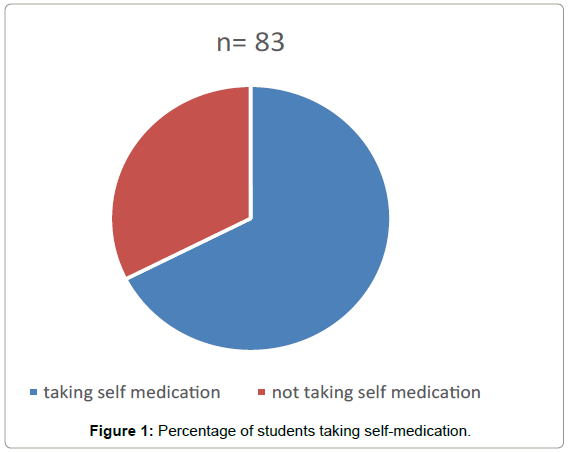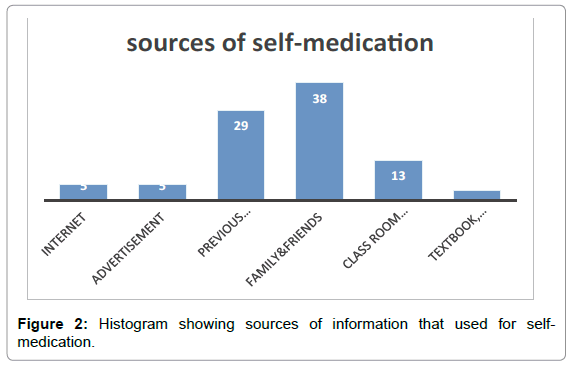Soni S*, Mukesh Kumar and Dheeraj Kumar Singh
Department of Pharmacology, All India Institute of Medical Sciences, Phulwarishariff, Patna, Bihar, India
*Corresponding Author:
Soni S
Department of Pharmacology
All India Institute of Medical Sciences
Phulwarishariff, Patna, Bihar, India
Tel: +919470123260
E-mail: dr.soni.rmch@gmail.com
Received Date: March 25, 2019; Accepted Date: April 01, 2019; Published Date: April 08, 2019
Citation: Soni S, Kumar M, Singh DK (2019) A Study on Pattern and Prevalence of Self-Medication among Second Year Medical Students. Int J Drug Dev & Res 11:09-11.
Keywords
P drug; Self-medication; Self-recognized illness; Drug prescription
Introduction
Self- medication is the selection and use of medicines by individuals to treat self-recognized illness or symptoms [1]. It is one of the component of self-care which is defined by WHO as what people do for their own selves to establish and maintain health, prevent and deal with illness. Self- medication not necessarily means the consumption of modern medicines but also includes herbs and home remedies [2]. Although in developed countries it is mainly restricted to over the counter medicine but in developing countries it may occur with both over the counter medicine and prescription only medicine [3,4]. In majority of illness self- medication is the first option which makes it a common practice worldwide. Self -medication if practiced rationally, will reduce the load on medical services by reducing time and cost especially in economically deprived countries with limited health care resources like ours. However if practiced irrationally it is going to raise the concern of misdiagnosis as well as increase the load of adverse drug reaction, emergence of drug resistance and drug dependence. Cases of self- medication reported all over world shows that in developing countries like India self- medication is the most preferred mode of self-care by the patient. Lack of strictness in drug marketing regulation and aggressive marketing campaigns by pharmaceutical companies have promoted self -medication to such extent that it has become a global health problem.
Various studies show highest prevalence of self -medication among individual belonging to medical profession [5], but there is lack of data available on current status of self -medication practices among medical students especially in north India region. Also the limited studies conducted in undergraduate medical students unable to show correlation between increasing pattern of self-medication and various determinant affecting it. Being future medical practitioner, self-medication has special impact on medical students. Keeping this in mind the present study has been planned to determine pattern of self- medication among Second year medical undergraduates and also to find out common ailments and common drugs used [6], reasons for self- medication [7] along with assessing relationship between the level of medical education [8] and the self- medication practices among medical undergraduates.
Aims and Objectives
1. To explore the pattern and prevalence of self-medication practices among Second year MBBS students,
2. Most probable determinants for such practices,
3. Most commonly drug used in self- medication,
4. Sources of information for self-medication,
5. Current attitude toward self -medication.
Materials and Methods
A questionnaire-based study was conducted among all medical students of Second year attending their respective practical classes in AIIMS, Patna pharmacy laboratory as provided in the supplementary file.
A brief description of nature of the study and procedure of completing the questionnaire was explained to students taking part in study.
Study design: Observational and analytical study.
Study duration: 1 Seating.
Sample size: 83 MBBS students.
Inclusion criteria
MBBS students of First year of all ages and both sexes.
Exclusion criteria
Those students who will be absent due to any reason at the time of questionnaire.
Statistical analysis of study
The survey was descriptive and data was summarized in counts and percentage. Microsoft word and excel programs was used for analysis of data.
Results
Total 83 students participated in the study voluntarily, out of them 60 (72%) were males and 23 (28%) were females. Mean age in years was 22; range was from 21 to 23 years. Total 9 students stated their health condition excellent whereas majority (56) stated their current health condition good and 8 of them stated their health condition fair. On asking about their degree of care they take of their health 67 of them stated to be careful whereas 16 stated they are careless in regard of their health care.
Out of 83 students total 56 students took Self-medication and the rest 27 students have not taken Self-medication ever till now. Among 83 students 7 of their Parents belonged to medical profession and all were taking self-medication (Figure 1).

Figure 1: Percentage of students taking self-medication.
Among the 56 students taking self-medication majority (35) stated they practice infrequently whereas 20 stated they rarely practice self-medication whereas 1 student stated he frequently practice selfmedication. Among self- medicated student majority followed allopathy (56) followed by ayurvedic (2). None of them followed homeopathy (Figure 2).

Figure 2: Histogram showing sources of information that used for self-medication.
Sources of information they used for self- medication were:
Medicines that they used for self -medication mainly came from:
• Medical store (48),
• Unused drug at home (13),
• Friends (11),
• Free physician samples (2).
Indication that they stated for their self- medication mainly came from:
• Fever (47),
• Cough and cold (42),
• Allergy (12),
• Skin problem (5),
• Menstrual symptoms (7),
• Stomach ache (12),
• Diarrhea (16),
• Constipation (7),
• Vomiting (11).
Drug that they commonly take for self -medication came out to be antipyretic (51), analgesic (38), antiallergic (18), antacids (17), herbal medicine, laxative (3), sedative (4), cough syrup (27), antimicrobials (8), multivitamins (10), antispasmodics (2), decongestant (7), lozenges (10).
Quick relief (30) and feeling of minor illness (33) were the most common reasons for taking Self-medication. Elven of the student had the thinking that doctor will prescribe me the same drug and five had confidence on their knowledge. Four students took self-medication to avoid crowd whereas one thought it would be more economical.
On asking them for the various aspect on awareness of self-medication before taking medicine most of the students (37) stated they have the awareness on dose and frequency of drug and were aware of the adverse effect they are going to face (27). Knowledge about expiry date of the drug was present in 49 students and 13 had awareness regarding importance of completing course of medication. 13 students had the knowledge about over the counter drug [9].
Among 27 student not taking self -medication majority didn’t take drug in the fear of risk of taking wrong drug, 13 student had lack of knowledge about medicine, six had risk of misdiagnosis, nine feared of adverse drug reaction [10], two had fear of drug dependence [11], Thirteen out of lack of knowledge about disease and nineteen thought it had risk of using wrong drug.
On asking the both group about their current attitude toward self-medication 39 students agreed that they are going to discourage their family and friends for self -medication and 4 agreed to promote reading leaflet of medicinal products. None of them claimed for encouraging the practice of self- medication among family and friends.
Many students had opinion that self -medication is acceptable if taken in urgency (17) or taken for minor illness (50). Six students thought they will continue to take self –medication and one had opinion that one can take self- medication if had a similar previous episode [12].
On asking the both group for the steps they can take to prevent self -medication majority replied that this can be done by promoting the awareness regarding adverse effect of self-medication (52) or by strict rules against the misleading pharmaceutical advertisement (35). Many had the opinion that health professional should be promoted to give proper instruction and explain what is prescribed in order to discourage self-medication. Limiting the supply of medicine without a valid prescription is also important. Two students had no opinion.
Conclusion
The study shows that self- medication is very common in medical students. Apart from the knowledge the students get in pharmacology, family and friends play the major motivational role in promoting self-medication. Also from the study it became clear that majority are practicing self-medication to provide quick relief or due to minor illness. The profession of parents of the students too influence intake of irrational practice of self-medication. Study also played a great impact in changing their attitude toward self-medication and irrational drug use.
Benefit of the Study
Based on our study we recommend following measures to reduce selfmedication:
• Reduce irrationality in prescription of medicine,
• Increase awareness regarding side effects and drug resistance,
• Strict rules against misleading pharmaceutical advertisement.
24215
References
- WHO Resource (1998) The role of the pharmacist in self-care and self-medication. Responsible self-medication.
- Bennadi D (2013) Self-medication: A current challenge. J Basic Clin Pharma 5: 19-23.
- Pereira FSVT, Bucaretchi F, Stephan C (2007) Self-medication in children and adolescents. J Pediatrics (Rio J) 83: 453-458.
- Goldsworthy RC, Mayhorn CB (2009) Prescription medication sharing among adolescents: Prevalence, risks, and outcomes. J Adolesc Health 45: 634-637.
- Ghaieth MF, Elhag SRM, Hussien ME, Konozy EHE (2015) Antibiotics self-medication among medical and nonmedical students at two prominent Universities in Benghazi City, Libya. J Pharma Bioallied Sci 7: 109-115.
- Samanta Bárbara Vieira de OliveiraSoraya Coelho Costa Barroso, Profile of drugs used for self-medication by elderly attended at a referral center
- Gráinne IB, Yvonne A, Aisling B, Finola L, Brenda AM, et al. (2016) The emergence and spread of multiple livestock-associated clonal complex 398 methicillin-resistant and methicillin-susceptible Staphylococcus aureus strains among animals and humans in the republic of Ireland, 2010-2014. PLoS ONE 11: e0149396.
- https://www.researchgate.net/publication/318497691_Association_between_Knowledge_of_Self_Medication_and_Adherence_among_Medical_Students_in_Dhaka_Bangladesh








